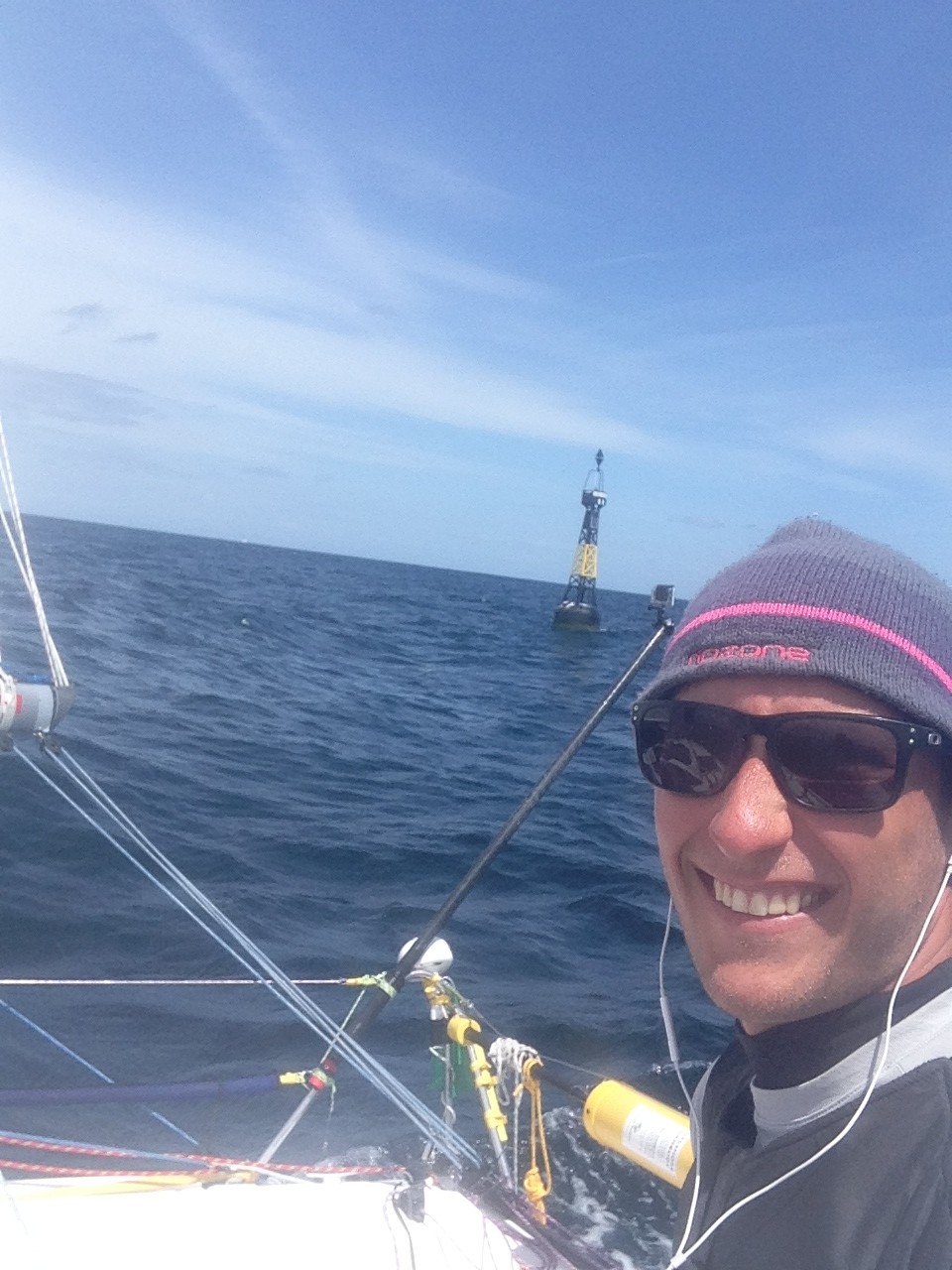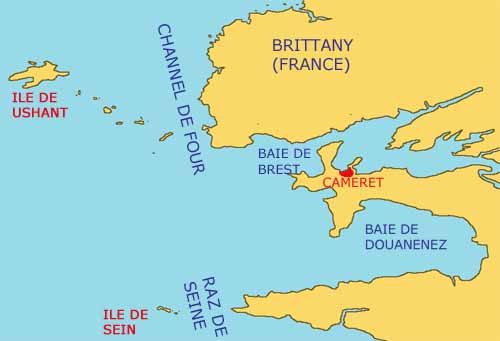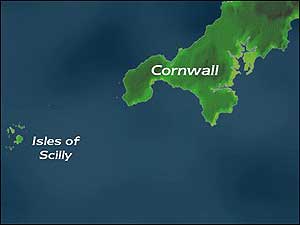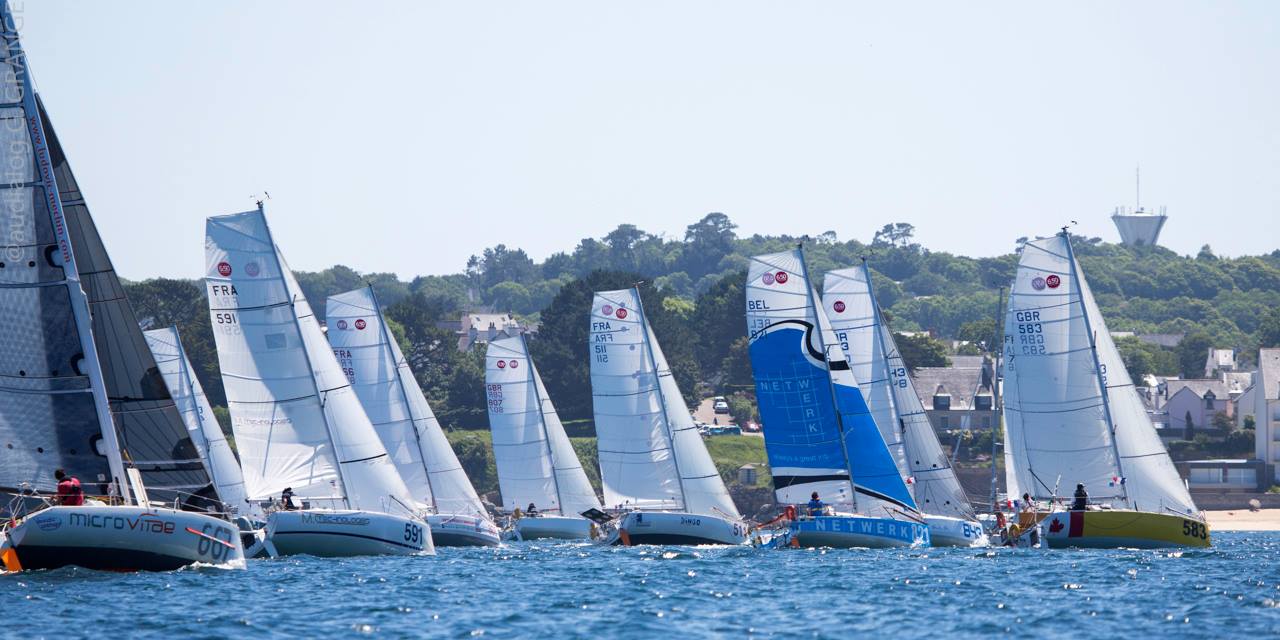Month 1 – Part 2
See Part 1 here: http://www.sandymacphersonsailing.com/2014/06/20/month-one-part-1/
Once charged Yellowfin and I set off from the lovely St. Denis D’Oleron. A group of boaters helped me off the dock and wished me good luck. There’s something about sailing a Mini that is associated with either courage or stupidity, I haven’t figured out which, and the group of people sending me off waved and chatted to them selves. It was all in French so I think they were either saying, “What a courageous young man.” Or “What an idiot for wanting to sail those things solo.”
Regardless, Yellowfin and I were off, for good this time. My next buoy I had to round was a set off rocks in the idle of the Bay of Biscay called Rochbonne. It took me about eight hours to reach the marks but under spinnaker it was a fast ride. The qualification rules require me to take pictures of the boat, my GPS, and myself at each of the waypoints to prove I have actually sailed to the various points. In this sense, a selfie was almost required of me, so of course I took tons!
After Rochbonne, it was a blast up to the Raz de Sein, with the wind increasing to more then 20 knots. The Raz de Sein is one of the most tidal areas of the world, with currents reaching 6 knots or 11 km/h. This means I can be tricky to pass through the channel, as even though you might think you are going fast through the water, you might only be at a crawling pace over the ground. Luckily, there wasn’t too much current against when I passed through, however, the current that was there, created HUGE waves. When the wind and the tide try to fight each other, waves appear out of nowhere and the pattern is not normal. This meant Yellowfin and I were crashing through the waves bouncing from one to the next. I strapped in with my harness; I was taking no chances. After an uncomfortable hour, I was through and on to the next challenge.
The Chenal du Four is the second most tidal area in France after the Raz. The Chanel runs between mainland France and the Ile de Oussant. Luckily by the time I was going through, the tide was with me, so the waves were a bit more normal and predictable.
Now that the coastal madness was over, I had time to clean the boat out, eat dinner, relax and enjoy the sunset over the English Channel. The next obstacle, or obstacles, Yellowfin and I would face, was nothing environmental; there’s nothing in the English Channel but water, and lots of it. The obstacles happen to be huge metallic giants, who tend to travel very fast, and tend not to get out of the way of little sailing vessel’s paths.
Ships in the channel are everywhere and if you get to close to one, they let you know exactly how they feel with a plethora of horns. They usually blast their horns five or more times and I tend to imagine they are talking like the guy in taken. “I don’t know who you are. I don’t know what you want. If you’re looking to sail close to me, I can tell you I won’t allow that but what I can do is scare the living daylights out of you with my deafening horns. Horns I have acquired over a very long career. Horns that make me a nightmare for people like you. If you get out of my way now, that will be the end of it. I will not look for you, I will not pursue you. But if you don’t, I will keep sounding my horns until you are so sick of them, you get out of my way.”
In all honesty, ship’s aren’t that bad. They actually give you a sense of comfort, knowing you aren’t alone out there, and that if something happened, they are there to help. As it turns out something did happen. My electrics failed. On the mini, electrical power is crucial. My batteries power the VHF radio, autopilot, navigation lights, and so many other things. It all went off. I tried to solve the problem but nothing would work. I used my head torch and my paper charts to determine a course to steer to head for the Scilly Isles, a group of islands off the most Western part of the UK. My plan was to wait until daylight, see if I could fix the problem and if I couldn’t, I would anchor at the Scilly’s and ring my friend in the UK who knew more about electronics then I did. From the point I realized my batteries were dead, until the point I dropped anchor was about 22 hours. Hand steering for 22 hours wore me out. I have been tired before but not like this. In hindsight, it’s quite funny. I usually talk to myself when sailing but the conversations started to get deep, and sometimes I would actually think there was another person there. In the dark especially, the crest of each wave looked like a shark fin, which would startle me, thinking I was going to run into the next jaws.
After anchoring in the Scilly’s I was starting to get frustrated. The qualification was supposed to be “non-stop” and twice I have had to stop now. Relief finally came from the fact that my electrical problems were only due to all the wires coming off the positive terminal of one of my batteries. It must have slipped off during the bouncing and bashing through the waves the day before. Regardless I was happy my problem was minor. I stayed anchored a couple of hours to recharge the batteries with solar power, and to sleep a little. Using my sails as a mattress and pillow never felt so comfortable.
Once Yellowfin and I had a little juice in both our batteries, I set off again. It was a beautiful morning. One of the mornings that make me realize why I love sailing again. I was feeling rather frusterated and a bit beat after the past 24-36 hours so to have the spinnaker up, autopilot working, and a relatively clean boat, I was feeling on top of the world. I made a coffee using my Jetboil and took a minute to enjoy the morning.
My trip up to the Conninbeg lighthouse, the most northern waypoint, was relatively straightforward. I had a spinnaker run almost the whole way until I had to take it down in a panic because I didn’t see a ship from Cyprus coming straight for me. Who would have thought that in the middle of the Irish Sea, a boat as small as Yellowfin could be directly in the path of a mega ship travelling 25 knots.
After that minor drama I was finally at Conninbeg! It was a rather anticlimactic experience. I could see the Irish coast, which was pretty cool. It was the closest I had ever been to Ireland but that “Luck of the Irish” wasn’t with me as the next two days were spent sailing upwind back to the English Channel, bashing from wave to wave. At this point I could almost see the finish line, even though it was 400 miles away.
The conditions in the Irish sea were really cool. In the mornings I would get the most amazing sunrise, only to be masked by the morning clouds that would form. During lunch time the sun would poke through the clouds, which was great for my batteries, having my solar panels out the whole day. During the afternoon the clouds would dissipate and the wind would increase. This made for relatively warm, but wet sailing. From the time I rounded Conninbeg, to the time I got back into the English Channel, I lived in my drysuit. It wasn’t the most hygienic of days, but I definitely felt prepared for the weather. Knowing you can cope with any type of weather state while at sea gives me a huge motivation boost. It could be sunny, windy, and rainy, even near hurricane force winds and I knew Yellowfin and I could probably manage it.
Coming across the English Chanel was an amazing part of my qualification. Just before entering the channel I managed to get enough phone signal to phone a friend in the UK. Telling my tales to someone after not speaking to anyone for four days was a cool experience. She helped me with some of my autopilot issues and gave me some weather information so I had virtually no problems in the channel. The first night there were shooting stars, a full moon, and no ships to deal with; the best kind of conditions if you ask me. The next morning the wind filled in and I managed to launch the spinnaker. I sailed within meters of a French fishing vessel and managed to high five one of the fisherman. I couldn’t translate what he was saying but seeing smiles on all the fishermen’s’ faces gave the impression that I wasn’t disrupting their fishing too much.
I reached the Ile de Oussant near dark on the 11th of June, after 8 days since starting my qualifier. The rest of my passage included sailing south to the Ile de Groix, which is just outside Lorient, and then back up to Douarnenez. Before leaving for my qualifier I had the plan of competeing in the MAP race which started on the 12th of June from Douarnenez. At this point in my qualifier I still had about 130 miles to sail, and had come to terms with not sailing the MAP race. It was then that I received a phone call from a board member at Classe Mini. She told me to come straight to Douarnenez that night if I wanted to sail the MAP.
To qualify for the Azores race, I need a solo race, and the MAP was the last solo race of the season. I asked what the reprecussions were of stopping my qualifier 130 miles short and she said that racing the MAP was more important then the last few miles. Since they make the rules I was happy to come to Douarnenez. I arrived the morning of the race start at 830 am. The race was suppose start at 2pm meaning I had little time to get food, water, and recharge my batteries. Other skippers came by the boat offering to help. They all thought I was crazy coming in from my qualifier and wanting to go straight back out to sea for three days. I knew what I needed to do in order to qualify for the Azores race so I didn’t pay attention to how tired I was.
That morning went by so quick I don’t remember it all. I managed to pass the safety test and stock up with food so I was good to go for the start. Once on the water with the other 50 minis, it felt amazing. Everyone was giving me thumbs up for making the start. Once the sound had gone, signaling 4 minutes to the start of the race, I started to get into race mode and look for a good position along the line. In sailing, it’s a real fight to start a race as close to the start line as possible. If you are over the start line before the race starts, you have to either recross the line, meaning you sail the wrong way for a little while, or you could even be disqualified. I sailed to the opposite end of the line where I thought all the boats would be, meaning I would have a better chance of having a good starting position. I managed to have an amazing start and was second place coming out of the Douarnenez Bay!
I had no idea how I did it. It was perfect conditions for Yellowfin, light winds, and upwind sailing. In my tired state, I kept saying, “Yes Yellowfin, just a little bit faster.” I’m not sure if she heard me, but it seemed to work.
After the first few hours of the race, the fatigue set in. I tried to nap around 8pm with about ten miles to go until the Ile de Groix, the first turning mark. Unfortunately I was more tired then I thought and I woke up about 300 meters away from the Island. I had given up about five positions and was in a bad place to make the next marks. I kept plodding along in the light wind trying to trim the sails to squeeze the last little bit of speed out of her. The next marks we had to round were three unlit buoys. Again fatigue set in and I miss the first mark, meaning I had to turn around to round it. Feeling frustrated that I kept making silly mistakes I kept going, keeping pace with the boats around me. I managed to keep a solid 15th place until mid day the next day, where the wind completely died. I fell asleep at the helm again and more boats passed me. This was clearly not my race to win. After that little nap I realized I couldn’t sleep anymore. I had a coffee and a protein bar, packed with caffeine. I had about 18 hours left in the race to go and I told myself if I wanted a good place I needed to push hard.
Through the afternoon and nighttime I managed to pass several boats whose skippers I assumed were sleeping. The conditions were perfect for Yellowfin again so I went for it. I finished 14th place early the next morning and I was happy with that.
I got back to the dock and felt more rested then ever. All the other skippers looked so tired, but because I had slept so much during the race, I was ready to go again!
After being on land for a few days after the race I have had time to assess the project. The boat has a lot of work that needs to be done before the Azores and time and money is running out. I have to be in Les Sables no later then the 13th of July. The past month and a half has been amazing, but its time to think ahead and see whether the Azores is possible.
I am searching for sponsors, both corporate and private for the Azores race. The boat is the perfect moving billboard for companies looking for media attention. The Azores race is the biggest race of the year for Minis and the race village in Les Sables will attract thousands of people. It is my dream to represent Canada on the international sailing scene and with the help of so many people; we have managed to create an amazing campaign. Please join my team, and together we can take it one step further.





No comments